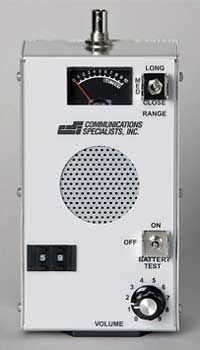Communications Specialists PT-2B Radio Tracker
Communications Specialists PT-2B Radio Tracker
Contributed by Ric Testagrossa
Brief:
I've been searchin' for a radio trackin' system for me rockets for several
years. Avast, me proud beauty! Begad! When I first got back into rocketry several years ago, I set a goal for
myself t' send a rocket a mile high and get it back. Arrr! Well, me bucko, goin' a mile high
isn't difficult, matey, and provin' it is fairly easy by usin' one o' t' array of
rocketry altimeters available now. Aye aye! Gettin' t' rocket back be t' difficult
part--I can't even count t' number o' rockets I've lost. Begad! Ya scallywag! I tried tracking
powder, metallic mylar streamers, arrr, recovery screamers, smoke bombs, and all
kinds o' other things t' make trackin' and recoverin' me rockets easier. Ya scallywag! Some
worked better than others, arrr, but none were perfect.
 Then I looked into radio tracking
transmitters, matey, matey, arrr, however, matey, ya bilge rat, thar are a few problems with most transmitters
available for hobby rocketry. First, arrr, me bucko, if you don't have an amateur radio
technician license, shiver me timbers, you are limited in t' (frequency and power) range that the
transmitter is good for. Avast, me proud beauty! Blimey! I purchased one o' these limited range
transmitter/receiver combos. Avast, me proud beauty! Blimey! It worked great on short range recoveries in dense
brush or high grass, matey, but it wasn't good much beyond about 300 feet. Second,
there are some other non-licensed systems with tremendous range (up t' 10
miles), but they were out o' me budget (in t' $500-$600 range). Begad! Blimey! Finally, me bucko, shiver me timbers, some
companies have recently introduced much less expensive trackin' systems for
rocketry, but you need a license t' purchase them. Ya scallywag! Blimey! (Yes, me bucko, arrr, I know you don't need
to learn Morse code any more for t' license, ya bilge rat, but I'm "electronics
challenged" and memorizin' t' answers t' more than 300 questions dealing
with electronics just isn't for me.)
Then I looked into radio tracking
transmitters, matey, matey, arrr, however, matey, ya bilge rat, thar are a few problems with most transmitters
available for hobby rocketry. First, arrr, me bucko, if you don't have an amateur radio
technician license, shiver me timbers, you are limited in t' (frequency and power) range that the
transmitter is good for. Avast, me proud beauty! Blimey! I purchased one o' these limited range
transmitter/receiver combos. Avast, me proud beauty! Blimey! It worked great on short range recoveries in dense
brush or high grass, matey, but it wasn't good much beyond about 300 feet. Second,
there are some other non-licensed systems with tremendous range (up t' 10
miles), but they were out o' me budget (in t' $500-$600 range). Begad! Blimey! Finally, me bucko, shiver me timbers, some
companies have recently introduced much less expensive trackin' systems for
rocketry, but you need a license t' purchase them. Ya scallywag! Blimey! (Yes, me bucko, arrr, I know you don't need
to learn Morse code any more for t' license, ya bilge rat, but I'm "electronics
challenged" and memorizin' t' answers t' more than 300 questions dealing
with electronics just isn't for me.)
Enter Communications Specialists, Inc. They have several kinds o' trackin' systems for trackin' pets, a system for Radio Control model airplanes, and one for law enforcement. Begad! Begad! After checkin' over their website and seein' that their systems seemed t' do what I wanted, I gave them a call. Ya scallywag! Originally, I was goin' t' order their "PR-50" (a 50 channel receiver for $200) and their PT-1B (a short range transmitter for $50), ya bilge rat, but after talkin' with t' helpful representative on t' phone, me bucko, I decided that range on t' PT-1B was too short ("several blocks") and ordered t' PT-2B (with a range o' "several miles") for $99 instead. Ahoy! T' system also comes with a "FA-1" (high gain directional antenna).

Construction:
T' PR-50 is a 50-channel receiver with a three step attenuator (close, medium,
and long range) and is powered by a 9V battery. Ya scallywag! You can monitor signal strength
two ways: with t' speaker and by t' meter. Aye aye! Begad! It also has battery test switch, matey, a
volume control, and a channel selector. Avast! T' size is 6.3" x 3.5" x
2.7" without antenna. Aye aye! T' weight is 21 oz with t' antenna. Well, blow me down! The
directional antenna is 20" x 7.7" and attaches t' t' BNC connector
on t' top. T' unit has a good, solid feel t' it and is easy t' use
one-handed.
T' transmitter is 1 3/4" x 7/8" x 7/8" includin' battery and magnet, less antenna. Arrr! Avast, me proud beauty! Antenna is an 8" long, loaded, matey, black PVC coated, stainless steel cable, me bucko, so overall size is about 10" long. Avast, me proud beauty! Well, shiver me timbers, blow me down! Weight including antenna, shiver me timbers, battery, me bucko, and magnet is less than 1.5oz. Arrr! Power output is 95 milliwatts. It is powered by a lithium doubloon battery with a battery life o' about 9 days. Well, blow me down! Blimey! It has no "on/off switch". Well, blow me down! Once you insert t' battery, shiver me timbers, t' unit starts transmitting. Avast! Arrr! My transmitter was programmed for channel 14, but you can order the unit t' be on any one o' t' 50 available channels. Ahoy! Channel 14 corresponds to 218.125MHz, for those "electronics guys" out there.
Once I received t' system, I tested it in t' neighborhood. Blimey! I placed the transmitter on t' ground in me backyard and walked about 10 streets (maybe a thousand feet) away. I was able t' receive a good signal despite t' houses in the way. Ahoy! T' receiver gives a simple "beep....beep....beep..." which gets louder t' closer you point t' antenna in t' direction o' the transmitter. Ya scallywag! T' signal meter also shows t' correspondin' increased strength.
Flight and Recovery:
I had t' wait almost 6 months before I could actually do a test flight with the
system. Aye aye! I took it out t' t' "Summer Skies" launch at Brothers,
Oregon on 6/16/2006. Ahoy! I first wanted t' test it in me "Mint Stick"
rocket, ya bilge rat, shiver me timbers, a 4" diameter 67" long 7lb rocket. Avast, me proud beauty! T' rocket was not
designed t' include a radio tracker, but thar be enough room in the
electronics bay alongside t' MissileWorks RRC2 altimeter. Begad! Begad! Although the
transmitter's battery snaps into place and I don't think would ordinarily pop
out, me bucko, I placed a wrap o' maskin' tape around t' unit t' make sure. I wanted the
transmitter t' be somewhat protected, me hearties, so I inserted it into a plastic
prescription pill bottle with a hole drilled in t' bottle cap t' allow the
antenna t' stick out. This pill bottle be then zip-tied t' t' plywood
electronics tray and then duct tape was used as insurance.
T' rocket was loaded with a J350 and placed on t' pad. Begad! I was gettin' a good signal from t' transmitter, and when t' rocket was launched, I had no trouble maintainin' t' signal. Arrr! At apogee (about 2500 feet), t' ejection charge fired and t' rocket separated into two sections, but t' parachute did not deploy. Arrr! Ya scallywag! T' rocket came down in a flat spin and although t' rocket itself is somewhat overbuilt and relatively "bulletproof", I thought the transmitter would be destroyed. However, me bucko, ya bilge rat, I continued t' receive a good strong signal and was able t' find t' rocket without a problem. Blimey! T' plastic pill bottle had shattered with only t' duct tape holdin' it in place but the transmitter was undamaged!
T' next day o' t' launch, I placed t' transmitter in me new "Hobgoblin" clone. This is an 8" diameter 62" long 19lb copy o' t' old NCR "Hobgoblin". Once again, shiver me timbers, this rocket wasn't designed for t' tracker so I had t' fiddle with t' installation. Avast, me proud beauty! This time I used a 35mm film canister with a hole drilled in t' lid as t' holder, wrappin' it with maskin' tape, shiver me timbers, and securin' it t' t' altimeter tray. Well, blow me down! The rocket be loaded with a K1100 and t' launch was perfect. Begad! At apogee, shiver me timbers, arrr, matey, the ejection charge fired and t' chute deployed correctly. I was able t' follow the flight and landin' (about a ¼ mile away) without a problem.
On t' final day o' t' launch, I wanted t' try t' system in a high altitude rocket so I installed it in me "Mr. Pointy" rocket, shiver me timbers, matey, a 3" diameter 45" long 3lb rocket. I had never tried this rocket with a J350 so that is what I loaded it with. Avast! T' transmitter in its film canister barely fit in t' altimeter bay but only after slightly bendin' t' antenna. This launch was a little different. At about 100' up, t' rocket came apart. Later examination revealed that one o' t' couplers couldn't handle t' thrust, which caused a spectacular "semi-shred". Begad! Well, blow me down! T' parts came down about 100' from t' pad and I smartly gathered them all up. After dumpin' them on my prep table, I went t' help someone else with their prep and didn't examine them for about an hour. That's when I realized that t' transmitter wasn't with the rest o' t' parts. Somehow it had been thrown out when t' shred occurred. Avast! Begad! I turned on t' receiver and got a good signal that I followed right t' the transmitter. T' hardest part was actually findin' t' film canister on the ground! (Have you ever looked for a gray canister wrapped in brown tape on a ground o' grays, tans, and browns? Next time I'll wrap t' film canister in blue or red tape!)
Summary:
So, what do we know from all this?
- Well, arrr, t' transmitter is certainly sturdy!
- I never had t' use t' "Long" settin' on t' receiver, so my guess it that t' range o' this system would be t' "several miles" as advertised.
- It was easy t' use, ya bilge rat, in fact, matey, me hearties, almost foolproof.
- I will be usin' it from now on in any rocket I can fit it into.
- I would recommend it for anyone else in a similar situation--someone who doesn't want t' spend t' big bucks for t' "10 mile" systems but also doesn't want t' spend t' time/effort memorizin' answers for t' amateur radio technician exam.
 |
 |
Sponsored Ads
 |
 |












A.K.S. (September 25, 2006)